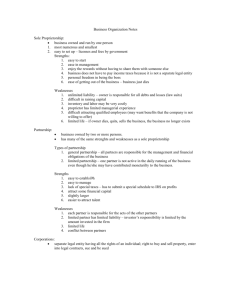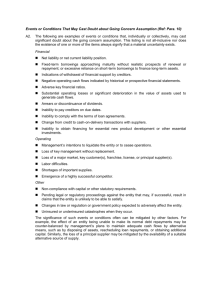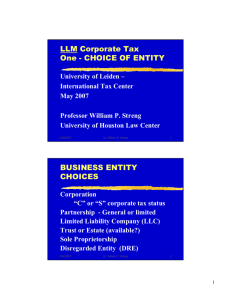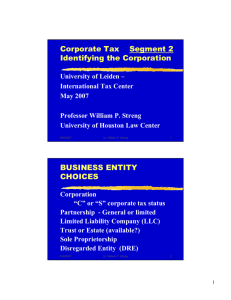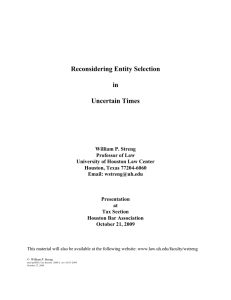LO 2 - Cengage Learning
advertisement
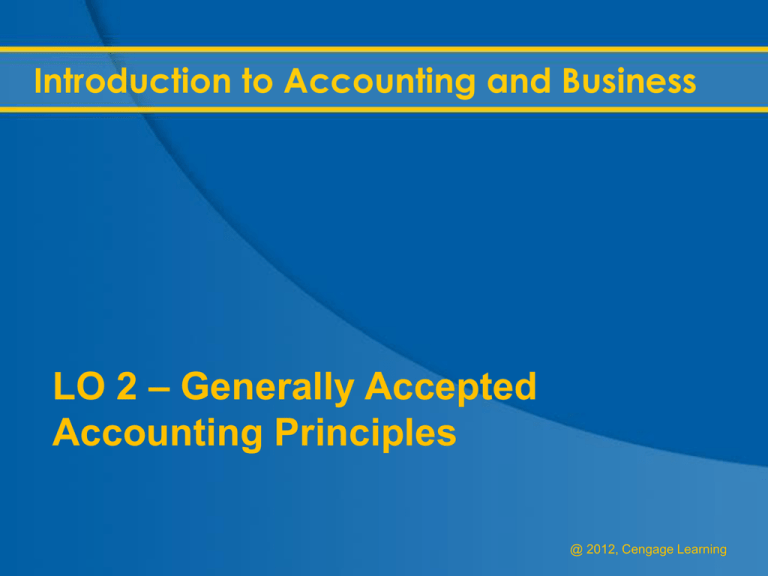
Introduction to Accounting and Business LO 2 – Generally Accepted Accounting Principles @ 2012, Cengage Learning LO 2 Generally Accepted Accounting Principles Financial accountants follow generally accepted accounting principles (GAAP) in preparing reports. Within the U.S., the Financial Accounting Standards Board (FASB) has the primary responsibility for developing accounting principles. LO 2 Generally Accepted Accounting Principles The Securities and Exchange Commission (SEC), an agency of the U.S. government, has authority over the accounting and financial disclosures for companies whose shares of ownership (stock) are traded and sold to the public. Many countries outside the United States use generally accepted accounting principles adopted by the International Accounting Standards Board (IASB). LO 2 Proprietorship A proprietorship is owned by one individual. 70% of business entities in the U.S. are proprietorships. They are easy and cheap to organize. Resources are limited to those of the owner. Used by small businesses. LO 2 Partnership A partnership is similar to a proprietorship except that it is owned by two or more individuals. 10% of business organizations in the U.S. (combined with limited liability companies) are partnerships. Combines the skills and resources of more than one person. LO 2 Corporation A corporation is organized under state or federal statutes as a separate legal taxable entity. Corporations generate 90% of business revenues. 20% of the business organizations in the U.S. are corporations. Ownership is divided into shares, called stock. (continued) LO 2 Corporation A corporation is organized under state or federal statutes as a separate legal taxable entity. Can obtain large amounts of resources by issuing stocks. Used by large businesses. LO 2 Limited Liability Company (LLC) A limited liability company (LLC) combines the attributes of a partnership and a corporation. 10% of business organizations in the U.S. (combined with partnerships). Often used as an alternative to a partnership. Has tax and legal liability advantages for owners. LO 2 Business Entity Concept Under the business entity concept, the activities of a business are recorded separately from the activities of its owners, creditors, or other businesses. LO 2 Business Entity Concept Owner Owner’s Business LO 2 Business Entity Concept Owner Owner’s Business The owner purchases merchandise for the business, and the business pays the amount due. LO 2 Business Entity Concept Owner Owner’s Business The business entity concept allows this entry in the owner’s business records because it relates directly to the activities of the business. LO 2 Business Entity Concept Owner Owner’s Business The owner buys a television set for home use by writing a check on his personal bank account. LO 2 Business Entity Concept Owner Owner’s Business The purchase of personal items with personal funds, even by the owner, is not an economic event that relates to the activities of the business. LO 2 Cost Concept Under the cost concept, amounts are initially recorded in the accounting records at their cost or purchase price. LO 2 Cost Concept Aaron Publishers purchased a building on February 20, 2010, for $150,000. Other amounts related to this purchased are shown on the next slide. LO 2 Cost Concept Price listed by seller on January 1, 2010 Aaron Publishers’ initial offer to buy on January 31, 2010 Purchase price on February 20, 2010 Estimated selling price on December 31, 2012 Assessed value for property taxes, December 31, 2012 $160,000 140,000 150,000 220,000 190,000 LO 2 Objectivity Concept The objectivity concept requires that the amounts recorded in the accounting records be based on objective evidence. Only the final agreed-upon amount is objective enough to be recorded in the accounting records. LO 2 Unit of Measure Concept The unit of measure concept requires that economic data be recorded in dollars.


